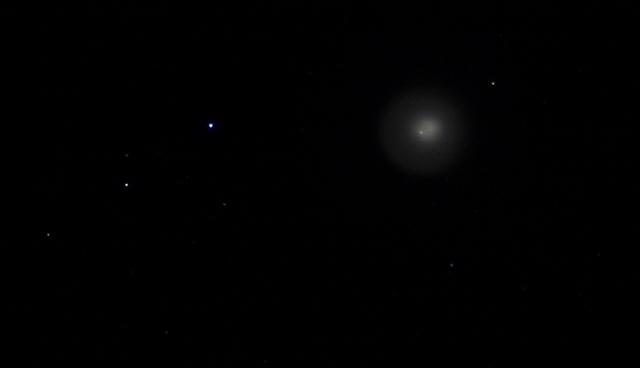Last updated: 24 November 2007
|
Last updated: 24 November 2007 |
This page documents Nikon D70 and other Nikon DSLR camera comments, tips, and photos. Search the site for "nikon dslr" for other items about the Nikon DSLR cameras. Contributions welcome.
Subject: ETX astrophotography Sent: Thursday, November 22, 2007 09:44:56 From: Pierre J. (piotr0r@gmail.com) Greetings, First I would like to tell you how much I like your site. I've been using my ETX for something like 8 years now, and back in the days, I was already reading your pages to find the information I needed, since I was much less experienced than I am now. In internet time, I think it's a serious achievment. My only regret with the ETX was that I couldn't take pictures with my Dimage 7. Things changed when I purchased a mighty Nikon D200 digital reflex. After a lot of trial and error (much trial, and lots of errors actually) I eventually managed to take moon pictures I'm satisfied with, and I thought that you could use them in your gallery to show what the ETX is really capable of at high resolution. Just click the link below to my flickr page, so that the jpeg won't clog up your mailbox :)The procedure is described in the photo caption, but to sum up, I polar-aligned my ETX on a sturdy photo tripod (using a single bolt, and it won't move or vibrate) with my Autostar, and I installed the D200 on its own tripod - this camera weighs a ton, just mating it with the ETX is closer to putting a brick on it than a camera. I didn't use an eyepiece so that the camera is at prime focus, no extension tube, which according to me gives the best sharpness possible. The setup looks like this :
sorry for the cheesy quality, it's a camera phone. So far, this moon picture is the best I could get, the only thing I didn't pay attention to was that my camera was set on JPEG rather than RAW (I soot all my astrophotography in RAW), but to me, it looks excellent, considering the features of the ETX and my improvised setup. Feel free to use those pictures if you want to :) In the meantime, I'm looking forward to reading you, Regards, Pierre Joliveau (France/Loiret)
Subject: Comet Holmes Nikon D70 Sent: Monday, October 29, 2007 20:52:20 From: Kevink (spunkyk98@wi.rr.com) it's been a while since I posted anything on your site, but comet Holmes got me going again. Here's an enlarged pic of the comet taken with a Nikon D70 thru a SV Nighthawk for 15 sec. mounted on a LXD75. This is a great comet! I can't wait to see how this comet plays out...

Subject: Nikon D40X DSL & Meade ETX-80AT-TC Sent: Thursday, October 25, 2007 22:35:00 From: J.M. Frahm (diplopunk@gmail.com) I stumbled across your site (as if Google actually 'stumbles') while looking for ways to use my ETX to take astrophotographs. I admit to being a novice in both the realms of digital photography (this is my first SLR camera) and astronomy (this is my first advanced telescope). I purchased a compatible t-mount and have successfully mated the D40X to the ETX. However, I don't have the first inclination how to use the new pairing. Thanks to your site, I managed to find the "bulb" setting on the camera, but I still couldn't focus well enough to snap shots of the full moon tonight. There seemed to be a lot of space inside the t-mount, so on a whim, I managed to place one of the ETX eye piece lenses inside the mount. I'm hoping this is the concept of "eyepiece projection". Tweaking the telescope focus, I had what looked like a sharp image of the moon through the camera's viewfinder. After an hour of playing around, I was getting excited to nearly reach my goal. However, snapping a few pictures, I got a large, white, circular blur. Guessing this was from some type of vibration, I tried using the 10-second timer (I haven't gotten around to purchasing a remote yet). The result was a similar white blur. I think I've made some progress in a very short time (thanks to your site), but I'm not sure what to try next. I appreciate your time and any insight you can offer. Regards, -- JarrodMike here: Yes, you are doing "eyepiece projection" when using the eyepiece. There are specific adapters available to properly hold the eyepiece and the camera. The vibration you are getting is from the "mirror movement". What you need to do is use the "hat trick" method: hold a "hat" (I use a piece of black cardboard) over the objective of the telescope, open the shutter ("bulb" setting), let the vibrations settle down, flip the "hat" out of the way for the exposure, then cover the objective again, and close the shutter. On bright objects like the Moon it will be a challenge to get a short enough exposure but with practice it can be done.
Go to the February-September 2007 Nikon DSLR Discussion page.
Go to the 2006 Nikon D70 Discussion page.
Go to the 2005 Nikon D70 Discussion page.
Go to my Nikon D70 Astrophotography page.
Go back to the Astrophotography Page.
Go back to my ETX Home Page.